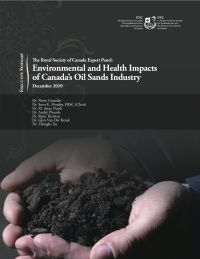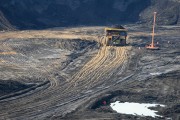Since the Royal Society of Canada released its 414-page tome on oilsands development yesterday, we haven't slept much. We live and breathe this stuff - so needless to say we've spent the last two days poring over the report.
The good news is this means you don't have to. We're not going to distill it all for you right now, because it's a week before Christmas and let's face it - 414 pages is a lot to take in. With that in mind, we're going to give you the lowdown on the report in bitesize pieces during the next few weeks.
 Let's start with an overview of some of the highlights. What we found most interesting, and what was picked up in a number of newspaper stories, is the sharp criticism leveled at government regulators for mismanagement of oilsands development.
Let's start with an overview of some of the highlights. What we found most interesting, and what was picked up in a number of newspaper stories, is the sharp criticism leveled at government regulators for mismanagement of oilsands development.
This is consistent with our research in the past decade that shows both levels of government are exacerbating international criticism of oilsands development by a combination of regulatory neglect and a lack of political will to implement regulatory improvements.
The report reinforced one of Pembina's key concerns on oilsands development - that "the regulatory capacity of the Alberta and Canadian governments does not appear to have kept pace with the rapid expansion."
The panel chair, Steve Hrudey, even noted that the take-home message of the report is that there are strong failures in the oilsands regulatory and oversight system, both at the federal and provincial levels.
Some of the other noteworthy criticisms were:
Inadequate government oversight
"The current visibility of relevant provincial and federal agencies, in particular in dealing with the major environmental challenges is low, and is generally not in line with those challenges" (p. 296)
Lack of data and a focus on public relations
"The Government of Alberta has a government-wide portal on its website to address oilsands, but the current content is largely public relations documents regarding the industry" (p. 296)
Lack of information to inform decision-making
![*Pembina experts and colleagues including [Dr. James Hansen;http://bit.ly/haslaC], Simon Dyer, Nathan Lemphers and Myles Kitagawa present to the ERCB. For the ERCB to make better decisions in the public interest, the Royal Society says more studies are needed on cumulative impacts. Photo Marc Huot, The Pembina Institute. Pembina presents to the ERCB](/images/blogs/300/os-hansen-enewsfall2010.jpg) "The ERCB faces difficult public interest determinations on future projects unless these information difficulties, especially on cumulative impacts, are corrected. Accordingly, the necessary studies need to be completed with highest priority to allow a sound evidence basis for public interest decisions . . . on project applications" (p. 296)
"The ERCB faces difficult public interest determinations on future projects unless these information difficulties, especially on cumulative impacts, are corrected. Accordingly, the necessary studies need to be completed with highest priority to allow a sound evidence basis for public interest decisions . . . on project applications" (p. 296)
Little progress made on cumulative effects
The Royal Society found that despite long standing commitments to cumulative effects assessment there has been, "Little tangible progress . . . in current regulatory policy." (p. 280)
As further evidence of a lack of resources or interest, the society notes the astonishing finding that Alberta's environmental regulators - the departments of Environment and Sustainable Resource development - have not even been appearing at oilsands project hearings (p. 289)
We also weren't terribly surprised to hear the response from the Alberta government. They agreed the report raises a number of issues that require attention, but also said some of these issues are being addressed, including the enhancement of both a stronger regulatory regime and assessment of the cumulative impacts of development over the region.
 The trouble is, the Alberta government has been promising improvements for a number of years now, but (with the noteworthy exception of tailings Directive 074) there has been virtually no actual policy change on the ground that shows regulations are improving. We would like to give the Alberta government credit for policy improvements, but progress is too slow to be meaningful in ensuring that development proceeds within the ecological capacity of the region. Meanwhile, the federal government continues to keep a low profile.
The trouble is, the Alberta government has been promising improvements for a number of years now, but (with the noteworthy exception of tailings Directive 074) there has been virtually no actual policy change on the ground that shows regulations are improving. We would like to give the Alberta government credit for policy improvements, but progress is too slow to be meaningful in ensuring that development proceeds within the ecological capacity of the region. Meanwhile, the federal government continues to keep a low profile.
Indeed, the Royal Society found little evidence that implementation of meaningful improvements has begun or will be achieved in an adequately rapid time frame. We are similarly wary based on our experiences with the Cumulative Effects Management Association, the Oilsands Multistakeholder Committee and the Alberta Water Council, where trust has been lost due to a continual failure on behalf of government to implement improvements and inaction has persisted.
The to-do list is long, and as more oilsands mine proposals loom, it is unclear if government has the resources to get the job done. An inadequate monitoring regime, an uncertain framework for the Athabasca River, a stalled wetland policy, undefined critical habitat for woodland caribou and a land use plan that is still not in place means that companies have little incentive to develop the resource responsibly. We know there is a lot of work in progress, but so far we haven't seen the changes on the ground that are needed.
The RSC thinks that concrete improvements could be achieved in part by:
- Undertaking a thorough comparison of current practices in environmental assessment against international practices, including health, social, economic, environmental, and sustainable development components, with a view to identifying international best practices.
- Implementing a central repository of regional environmental, community health, and infrastructure data that provides effective public access.
- Implementing cumulative assessment, which requires the foregoing and a coordinated effort to review, analyze, and interpret regional data to set targets with a publicly accessible process that define cumulative capacity limits, as has been done with water use
The rate of growth in oilsands production during the past five years compared to the lack of progress on filling environmental policy gaps paints a stark picture of where both governments have placed their priority.
Will the Royal Society report usher in a new period of serious attention to environmental improvements? That's up to the Alberta and federal governments to decide.









